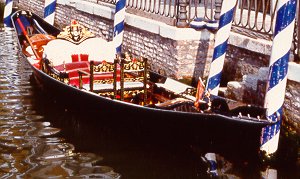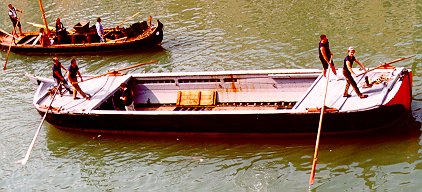OTHER
ROWING BOATS
![]()
Sàndolo:
the most commonly used boat of the lagoon. It varies from
5 to 9 m in length, has flat sides, a straight bow stem
inclined forwards with a straight-cut stern.
The many variations of this boat are to adapt it to many
uses: fishing (sàndolo a la ciosòta, sandolo
buranèlo, sàndolo sampieròto), for
recreation and regattas (mascaréta, pupparìn),
hunting, carrying passengers, and so on. ![]()
Sàndolo da
s'ciòpo o S'ciopón:
small boat about 5.25 m long, 1 m wide and 30 cm high.
 It was
used by the inhabitants of the estuary to hunt ducks
using a technique called col s’ciopòn. The
hunter followed the game around the lagoons in this light
boat rowing with two crossed oars, threw bait from the sàndolo
and using a small oar called a pénola (feather)
or palina (small spade) he closed in on the ducks, shooting them with a large (3 m-long) type of
musket or s’ciopo (from which the boat gets
its name).
It was
used by the inhabitants of the estuary to hunt ducks
using a technique called col s’ciopòn. The
hunter followed the game around the lagoons in this light
boat rowing with two crossed oars, threw bait from the sàndolo
and using a small oar called a pénola (feather)
or palina (small spade) he closed in on the ducks, shooting them with a large (3 m-long) type of
musket or s’ciopo (from which the boat gets
its name).
 Sàndolo
da barcariòl: used in Venice to transport tourists, painted black and equipped with parécio
(that is chairs, a central divan, gilded horses on the sides, etc.), it is easily mistaken for a gondola by
tourists, and serves the same function.
Sàndolo
da barcariòl: used in Venice to transport tourists, painted black and equipped with parécio
(that is chairs, a central divan, gilded horses on the sides, etc.), it is easily mistaken for a gondola by
tourists, and serves the same function.
Nowadays a space is cut from the stern deck for the
insertion of an off-board motor used for longer excursions.
Batèla
buranela:  Venetian transport boat with the straight-cut
stern and the bow stem curved and extended forwards like
that of the tòpo. With a solid and economical construction, it is still used to transport building
materials. The oarsmen stand over the bow and stern decks
leaving the central space free for the load. It derives
from the more ancient batèla a còa de gàmbaro.
Venetian transport boat with the straight-cut
stern and the bow stem curved and extended forwards like
that of the tòpo. With a solid and economical construction, it is still used to transport building
materials. The oarsmen stand over the bow and stern decks
leaving the central space free for the load. It derives
from the more ancient batèla a còa de gàmbaro.
![]()
Caorlìna:
a beautiful lagoon boat with rounded, symmetrical stern
and bow and half-moon stems with vertical ends, parallel
sides, with a large capacity but retaining its elegance.
Few examples of traditionally-built caorlìne
have been conserved, but there are many reconstructions
for recreation and regattas made in marine ply-wood.
The caorlìna can be used both with oars (up to
6 oarsmen) and sails. It was used for transport and for
fishing a seràgia, in which case a low cabin
for the fishermen (camaròto) was built into the
stern.
Since 1951 the caorlìne have been used for the
Venetian Historic Regatta with a crew of 6 oarsmen. It is
9 m long, 1.56 metres wide, with a bottom width of 0.56
m, and a mid-length height of 0.56 m. It weighs approx.
380 kg.![]()

Peàta:
also piatta; this was the most important
transport boat for the city canals in Venice. Similar to
the caorlìna, but larger and less slender, it
was designed to obtain the maximum cargo capacity. The peate
were built with half-moon stems (the later versions had a
sraight stern stem), with the hull almost parallel, with
a flat bottom and with two covers at the extremities with
a hatch and two bitts each.
It was built in various sizes which ranged from 100 to
250, 400, and over 800 hundredweight. It was usually
propelled by two oarsmen who used the fórcole
or the simpler vogarìssi; the stern oarsman
kept the boat on course moving the rudder with his feet.
In the narrower canals, the oarsmen propelled the boat by
a form of punting (paràndo - a technique also
used for the bùrci), in
which the oar is pushed into the canal bottom, the
oarsman places the top of the oar against his shoulder,
walking backwards along the side of the boat. The boat
was always (literally) pitch-black, the only decoration
being two white circles (bóli) or two white
bands (catelàne) painted on the bow and the
stern.![]()